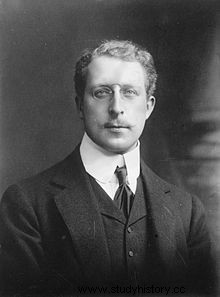Albert I, Prince of Belgium, Duke of Saxony, Prince of Saxe-Coburg-Gotha, heir apparent to the crown (1891-1909), born in Brussels on April 8, 1875 and died in Marche-les-Dames on February 17, 1934. He was the third King of the Belgians from December 23, 1909, on the death of his uncle Leopold II. He was the son of Prince Philippe, Count of Flanders (the brother of Leopold II) and Princess Marie of Hohenzollern-Sigmaringen. On October 2, 1900, he married Elisabeth, Duchess in Bavaria (house of Wittelsbach), Princess of Belgium, Queen of the Belgians (1909- and by courtesy until her death in 1965) with whom he had three children:
* Leopold, (future Leopold III)
* Charles, Prince of Belgium, Count of Flanders, Regent of the Kingdom from 1944 to 1951, born October 10, 1903 and died June 1, 1983. He married September 14, 1977, Jacqueline Peyrebrune
* Marie-José, Princess of Belgium, Queen of Italy (1946), born August 4, 1906 and died January 27, 2001. She married Umberto (15/09/1904-18/03/1946) of Piedmont, Prince of 'Italy, King of Italy. She then became Queen of Italy for just...a little over a month (05/09/1946-06/13/1946) which gave her the nickname "Queen of May".
N.B.:After the First World War (1914-1918), Albert I no longer had the titles Duke (Hesse) of Saxony and Prince (esse) of Saxe-Coburg-Gotha, which were of German origin (Duchy of Saxony) , origin of the invader. However, these titles are still present on certain official acts (birth and death certificates...)
From 1893 to 1909, Prince Albert was a senator by right and gave speeches on improving the country's naval, rail and road infrastructure. In 1906, he created the Œuvre royale de l'Ibis, a school on the Belgian coast for young disadvantaged fishermen.
The people felt a great deal of sympathy for him and his queen, who led a simple life, without much pageantry. On December 23, 1909, the crowd present in Brussels therefore gave a particularly warm welcome to the new King. Albert I was the first sovereign to take the oath in French and Dutch.
In Europe, when the tension increased, the countries began to conclude alliances and to prepare their weapons. In 1913, King Albert visited Germany and France to insist on Belgium's neutrality and to warn them that if they violated Belgian territory, Belgium would defend itself. He also ratified the Compulsory Military Service Act. This measure increased the army contingent from 180,000 to 340,000 men.
In 1914, the Great War broke out. On August 2, Germany issued an ultimatum to Belgium:the Emperor, although linked to the Belgian family, demanded the free passage of his troops, failing which Belgium would be considered an enemy. Albert refuses, takes command of the army. On August 4, the Germans invaded Belgium. After a fierce struggle in Liège and Antwerp, the Belgian army took refuge behind the Yser on October 15. It will last four years.
The King refuses to follow the government to Sainte-Adresse, in the suburbs of Le Havre and remains at the head of the army to direct it. He regularly visits the front to encourage his men. His bravery earned him the nickname "Soldier King" or "Knight King".
After the First World War, King Albert I represented Belgium at the peace negotiations in Versailles, defending the interests of his country but also trying in vain to oppose Germany's policy of excessive humiliation. He then devoted his energy to the promotion of major works of public utility to restore the country plundered under occupation. The finest example is the canal that connects the ports of Liège and Antwerp:it will bear his name. Passionate about science, in 1928 he created the National Fund for Scientific Research (F.N.R.S.). Very attentive to the linguistic problems which were beginning to tear the country apart, he favored the Flemishization of the University of Ghent in 1930. With his wife Queen Elizabeth, King Albert I was the friend of many artists, writers and scientists.
A rock climber, he died following a fall on the rocks of Marche-les-Dames, in the Meuse valley, near Namur, on February 17, 1934. He is buried with his ancestors in the royal crypt of the Church of Our Lady of Laeken.
His attitude and his determination during the war and his accidental death contributed to create a real myth around his personality.

